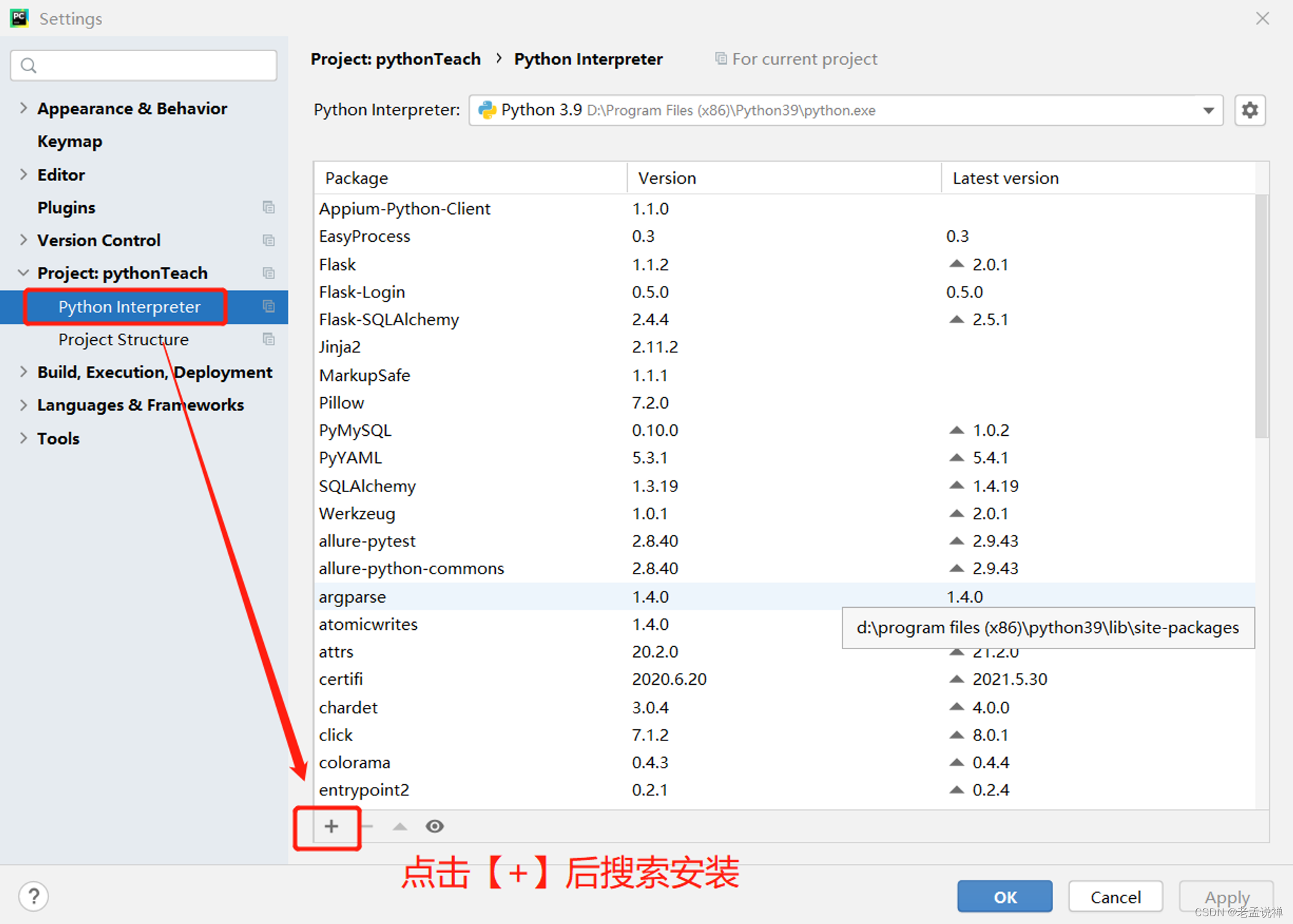Python基础之数据库操作
发布时间:2024年01月23日
一、安装第三方库PyMySQL
1、在PyCharm中通过 【File】-【setting】-【Python Interpreter】搜索 PyMySQL进行安装

2、通过PyCharm中的 Terminal 命令行 输入: pip install PyMySQL
注:通过pip安装,可能会提示需要更新pip,这时可执行:pip install --upgrade pip 进行更新pip
二、mysql数据库查询(SELECT)
1、pymysql.connect()连接数据库
import pymysql
connect = pymysql.connect(host='101.37.246.001', # 数据库地址
port= 3306, # 数据库端口,mysql一般默认为3306
user='xxxx', # 用户名
password='xxxx', # 登录密码
database='movie_cat', # 要连接的数据库名
charset='utf8') # 数据库编码,一般默认utf8
?2、使用 cursor( ) 创建游标
import pymysql
connect = pymysql.connect(host='101.37.246.001', # 数据库地址
port= 3306, # 数据库端口,mysql一般默认为3306
user='xxxx', # 用户名
password='xxxx', # 登录密码
database='movie_cat', # 要连接的数据库名
charset='utf8') # 数据库编码,一般默认utf8
with connect.cursor() as cursor: # 创建游标
3、使用 execute( ) 执行sql语句
?
import pymysql
connect = pymysql.connect(host='101.37.246.001', # 数据库地址
port= 3306, # 数据库端口,mysql一般默认为3306
user='xxxx', # 用户名
password='xxxx', # 登录密码
database='movie_cat', # 要连接的数据库名
charset='utf8') # 数据库编码,一般默认utf8
with connect.cursor() as cursor: # 创建游标 # 创建游标
sql = 'SELECT * FROM movie2 '
cursor.execute(sql) # 执行sql语句
4、执行sql语句后,需要调用 fetchone() 或 fetchall() 方法来获得查询的返回结果
- fetchone(): 该方法获取第一个查询结果集。结果集是一个对象,连续多次执行将依次取得下一条结果,直到为空;
- fetchall():?接收全部的返回结果行
import pymysql
connect = pymysql.connect(host='101.37.246.001', # 数据库地址
port= 3306, # 数据库端口,mysql一般默认为3306
user='xxxx', # 用户名
password='xxxx', # 登录密码
database='movie_cat', # 要连接的数据库名
charset='utf8') # 数据库编码,一般默认utf8
# cursorclass=pymysql.cursors.DictCursor 设置游标返回结果为字典
with connect.cursor() as cursor: # 创建游标
sql = 'SELECT * FROM movie2 '
cursor.execute(sql) # 执行sql语句
data = cursor.fetchall() # 接收全部返回的结果,返回一个元祖类型
print(f"数据库查询数据:{data}")
print(type(data))
connect.close() # 关闭数据库连接
数据库查询数据:((1, 'My Neighbor Totoro', '1988'), (2, 'Dead Poets Society', '1989'), (3, 'A Perfect World', '1993'), (4, 'Leon', '1994'), (5, 'Mahjong', '1996'), (6, 'Swallowtail Butterfly', '1996'), (7, 'King of Comedy', '1999'), (8, 'Devils on the Doorstep', '1999'), (9, 'WALL-E', '2008'), (10, 'The Pork of Music', '2012'), (12, 'huawei', '2020'))
<class 'tuple'>二、mysql数据库更新数据(UPDATE)?
import pymysql
connect = pymysql.connect(host='101.37.246.001', # 数据库地址
port= 3306, # 数据库端口,mysql一般默认为3306
user='xxxx', # 用户名
password='xxxx', # 登录密码
database='movie_cat', # 要连接的数据库名
charset='utf8') # 数据库编码,一般默认utf8
with connect.cursor() as cursor: # 创建游标
sql = 'UPDATE movie2 SET year = 1998 WHERE id = 1 '
cursor.execute(sql) # 执行sql语句
connect.commit() # 提交数据到数据库
connect.close() # 关闭数据库连接在cursor( ) 创建游标后通过execute( ) 执行sql,需要通过connect实例调用commit( ) 进行数据提交
三、mysql数据库插入数据(INSERT)
import pymysql
connect = pymysql.connect(host='101.37.246.001', # 数据库地址
port= 3306, # 数据库端口,mysql一般默认为3306
user='xxxx', # 用户名
password='xxxx', # 登录密码
database='movie_cat', # 要连接的数据库名
charset='utf8') # 数据库编码,一般默认utf8
with connect.cursor() as cursor: # 创建游标
sql = "INSERT INTO movie2(title, year) VALUES ('firstday', '2021');"
cursor.execute(sql) # 执行sql语句
connect.commit() # 提交数据到数据库
connect.close() # 关闭数据库连接?四、mysql数据库删除数据(DELETE)
import pymysql
connect = pymysql.connect(host='101.37.246.001', # 数据库地址
port= 3306, # 数据库端口,mysql一般默认为3306
user='xxxx', # 用户名
password='xxxx', # 登录密码
database='movie_cat', # 要连接的数据库名
charset='utf8') # 数据库编码,一般默认utf8
with connect.cursor() as cursor: # 创建游标
sql = "DELETE FROM movie2 WHERE id = 13;"
cursor.execute(sql) # 执行sql语句
connect.commit() # 提交数据到数据库
connect.close() # 关闭数据库连接注:insert/delete/update后都需要调用commit( )提交数据到数据库,完成事务提交
封装一个数据库操作类
class ConnectDB:
config = {
"host":'47.103.126.208',
"user":'siyuan',
"password":'123456',
"database":'mall',
"charset":'utf8',
#"cursorclass":"pymysql.cursors.DictCursor"
}
def __init__(self):
self.connect = pymysql.connect(**self.config)
def select_datas(self, sql):
with self.connect.cursor(pymysql.cursors.DictCursor) as cur:
cur.execute(sql)
data = cur.fetchall()
print(data)
print(type(data))
return data
def charge_datas(self, sql):
pass
def connect_close(self):
self.connect.close()
def __call__(self, act=None, sql=None, connect=True):
if connect:
if act == 'select':
datas = self.select_datas(sql)
return datas
elif act in ['update', 'insert', 'delete']:
self.charge_datas(sql)
return self
else:
self.connect_close()
if __name__ == '__main__':
connect_db = ConnectDB()
sql = "SELECT * FROM ls_user WHERE nickname LIKE '%思源%';"
data1 = connect_db('select', sql)
data2 = connect_db('select', sql)
connect_db(connect=False)?
?
?
?
?
?
?
?
?
?
文章来源:https://blog.csdn.net/weixin_48647112/article/details/135792690
本文来自互联网用户投稿,该文观点仅代表作者本人,不代表本站立场。本站仅提供信息存储空间服务,不拥有所有权,不承担相关法律责任。 如若内容造成侵权/违法违规/事实不符,请联系我的编程经验分享网邮箱:chenni525@qq.com进行投诉反馈,一经查实,立即删除!
本文来自互联网用户投稿,该文观点仅代表作者本人,不代表本站立场。本站仅提供信息存储空间服务,不拥有所有权,不承担相关法律责任。 如若内容造成侵权/违法违规/事实不符,请联系我的编程经验分享网邮箱:chenni525@qq.com进行投诉反馈,一经查实,立即删除!
最新文章
- Python教程
- 深入理解 MySQL 中的 HAVING 关键字和聚合函数
- Qt之QChar编码(1)
- MyBatis入门基础篇
- 用Python脚本实现FFmpeg批量转换
- 工智能基础知识总结--什么是BERT
- C++ 代码中如何使用互斥锁std::mutex和独占锁std::unique_lock
- MFC为对话框资源添加类
- [PyTorch][chapter 7][李宏毅深度学习][深度学习简介]
- pyechart基础
- Java版企业电子招标采购系统源码Spring Cloud + Spring Boot +二次开发+ MybatisPlus + Redis tbms
- Linux_Docker图形化工具Portainer如何安装并结合内网穿透实现远程访问
- Element-ui自定义表格头部-添加筛选条件
- 测试用例基础知识
- wps的excel级联设置